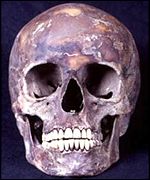 Latest fossil find in Africa strengthens chain of human evolution
Latest fossil find in Africa strengthens chain of human evolution
"We just found the chain of evolution, the continuity through time," study co-author Berhane Asfaw, an Ethiopian anthropologist, said in a phone interview from Addis Ababa. "One form evolved to another. This is evidence of evolution in one place through time."
The findings were reported Thursday in the scientific journal Nature.
 [ New Skeleton found in same region as Lucy (Image: DCI) ]
[ New Skeleton found in same region as Lucy (Image: DCI) ]The species anamensis is not new, but its location is what helps explain the shift from one early phase of human-like development to the next, scientists say. All eight species were within an easy day's walk of one another.
Until now, what scientists had were snapshots of human evolution scattered around the world. Finding everything all in one general area makes those snapshots more of a mini home movie of evolution.
"It's like 12 frames of a home movie, but a home movie covering six million years," said study lead author Tim White, co-director of Human Evolution Research Center at University of California at Berkeley.
"The key here is the sequences," White said. "It's about a mile thickness of rocks in the Middle Awash and in it we can see all three phases of human evolution."
Modern man belongs to the genus Homo, which is a subgroup in the family of hominids. What evolved into Homo was likely the genus Australopithecus (once called "man-ape") which includes the famed 3.2 million-year-old "Lucy" fossil found three decades ago. A key candidate for the genus that evolved into Australopithecus is called Ardipithecus. And Thursday's finding is important in bridging - but not completely - the gap between Australopithecus and Ardipithecus.
In 1994, a 4.4-million-year-old partial skeleton of the species Ardipithecus ramidus - the most recent Ardipithecus species - was found about 10 kilometres from the latest discovery.
"This appears to be the link between Australopithecus and Ardipithecus as two different species," White said. The major noticeable difference between the phases of man can be seen in Australopithecus' bigger chewing teeth to eat harder food, he said.
While it's looking more likely, it is not a sure thing that Ardipithecus evolved into Australopithecus, he said. The finding does not completely rule out Ardipithecus dying off as a genus and Australopithecus developing independently.
The connections between Ardipithecus and Australopithecus have been theorized since an anamensis fossil was first found in Kenya 11 years ago. This draws the lines better, said Alan Walker of Penn State University, who found the first anamensis and is not part of White's team.
Rick Potts, director of the Smithsonian's Human Origins Program, agreed: "For those people who are tied up in doing the whole human family tree, being able to connect the branches is a very important thing to do."
![BOIS-CAIMAN-1791-CLUB [the african memory]](https://blogger.googleusercontent.com/img/b/R29vZ2xl/AVvXsEjthfqy-hYzHw7sv58_RVCAameV_WrAgeWBzAhb5XeeFpM9EQegROHsrbJriUiTEbev2AudKEXMVqS4mZLgE3bgcQ6mNUNWzvXUhyphenhyphen-ugR-pL7ymfmq4WxS1dfBAtcPJFANmmtZZrVlYeFgx/s963/BannerBEST-aktuell----.gif)













































0 Kommentare:
Kommentar veröffentlichen